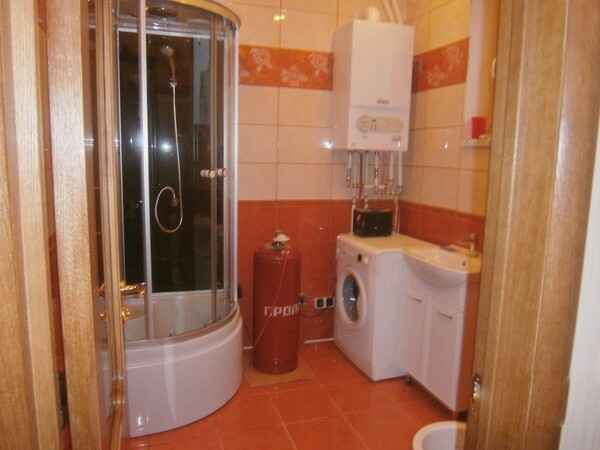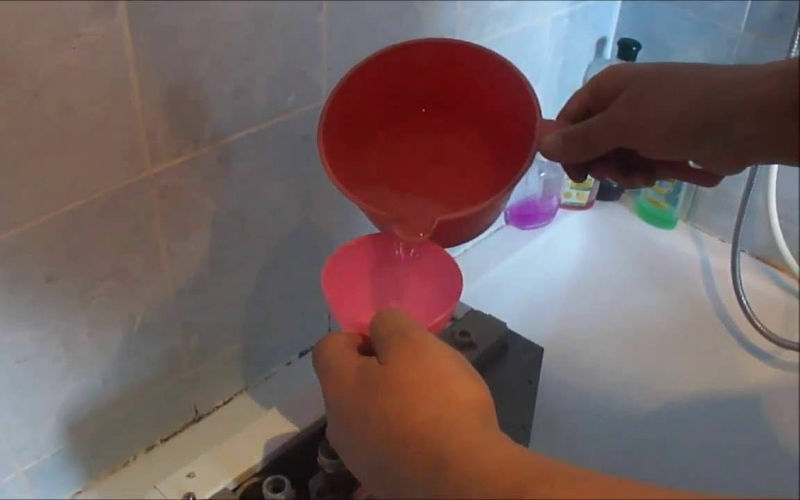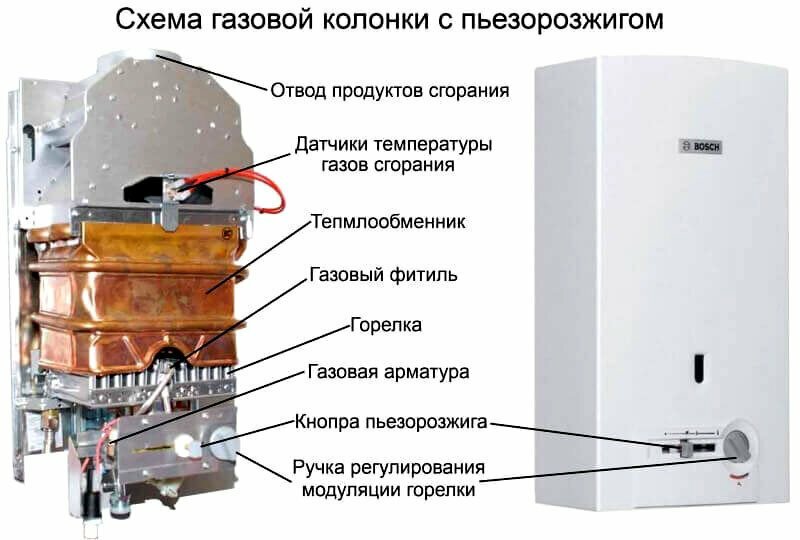If there is no hot water supply in your house, or if you constantly turn off hot water, then life becomes completely uncomfortable. But that's not a reason to give up a warm shower on a cool autumn evening, right? This problem can be solved by installing a gas column, as many users do. But how does such a miniature water heater work and can it cope with its task?
We will talk about all this in detail in our publication - here we consider the principle of operation of the gas column, the diagrams of its device. It also focuses on the main equipment malfunctions and ways to cope with them. The presented material is supplemented with visual illustrations, diagrams and videos.
The content of the article:
- The general structure of the household column
-
How does a gas water heater work?
- Gas ignition method
- Column water assembly device
- Combustion chamber type
- Key features of the speakers
- Safety sensors and their meaning
- Basic problems and how to fix them
- Conclusions and useful video on the topic
The general structure of the household column
A gas water heater is instantaneous water heater. This means that the water passes through it and heats up along the way. But, before proceeding to the analysis of how a household gas water heater is arranged for heating water, we recall that its installation and replacement are associated with a centralized gas supply system.
Therefore, it is imperative to submit documents to the gas service of your region along with the corresponding application. O norms and necessary documents You can read it in our other articles, but now let's move on to the device.
Various models of gas water heaters differ among themselves, but the general structure of a household gas water heater looks like this:
- Gas-burner.
- Igniter / ignition system.
- Exhaust hood and chimney connection.
- Chimney pipe.
- The combustion chamber.
- Fan (on some models).
- Heat exchanger.
- Gas supply pipe.
- Water node.
- Water inlet nozzles.
- Hot water outlet.
- Front panel with controller.
The central element of the column is gas-burner, in which the combustion of gas is maintained, which contributes to the heating of the water. The burner is installed in the body, it collects hot combustion products, the purpose of which is to heat water.
Frame made of metal and completely covers the front and sides of the speaker. It is important that the material of the case conducts heat well, because the quality of heating depends on the transmission of heat to it.
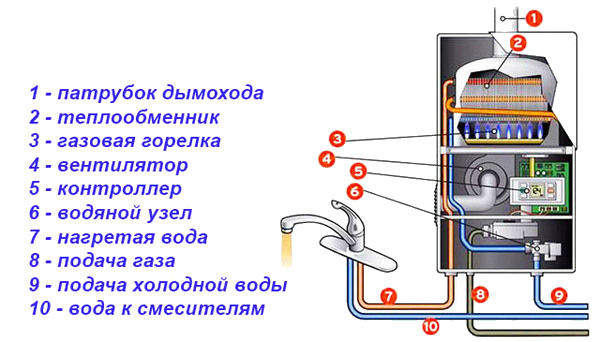
Structural components of the gas water heater located inside the body. Shown here is a closed-type gas equipment
On top of the device is hood and chimneythrough which the combustion products leave the column and the room. Their device depends on whether the speaker is open or closed, which will be shown below.
The pipes twist like a coil inside the body, water passes through them under natural pressure and is warmed by hot gases. This whole pipe system is called heat exchanger. Below there are two branch pipes: on the right - for receiving cold water from the pipeline, on the left side hot water flows out.
Between the water supply network and the gas water heater is often installed filterwhich regulates the hardness of the water. Without a filter, the column can be covered with limescale at high water temperatures. When entering the column, water passes through water node, which serves as a kind of "connection" between the flow of water and the flow of gas. We will talk about this connection a little further.
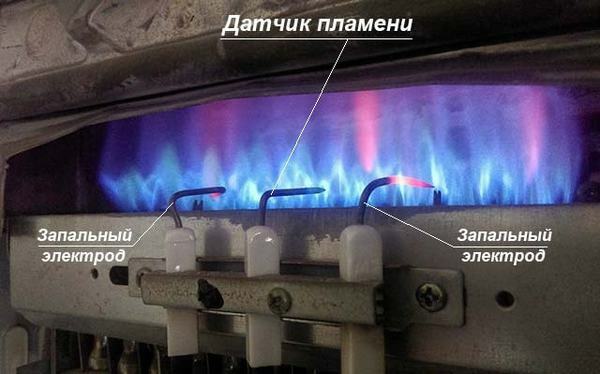
Burning gas burner with electric ignition and flame sensor. Sensors play an important role in the functioning of equipment. Let's talk about their functions further.
With the help of another tube, which is also located at the bottom, the column is connected to the gas main.
There is also a front panel with control unit. It is equipped with regulators to control the consumption of gas and water. Depending on the model, these can be both simple knobs that need to be twisted, and liquid crystal displays, where you can see many characteristics of the column, or even the nature of its malfunction if the column is not works.
How does a gas water heater work?
Let's get acquainted with the principle of operation of a gas column in the form of a simple algorithm:
- when water flows through the water assembly, the membrane strains and moves up the stem connected to the gas valve;
- then the valve opens the gas supply to the main burner;
- the gas is ignited from an electrode or igniter, burns out and heats up the water that flows through the pipes of the heat exchanger;
- the heated water flow is supplied to the tap through the left branch pipe;
- gas combustion products are removed through the chimney or exhaust hood - there is a fundamental difference between open and closed columns, which will be described in detail below.
At the same time, the power of the flame and the power of water flow through the column can be adjusted using the controls on the front panel.
And now let's take a closer look at how the burner is ignited and how the already mentioned water unit is connected with this.
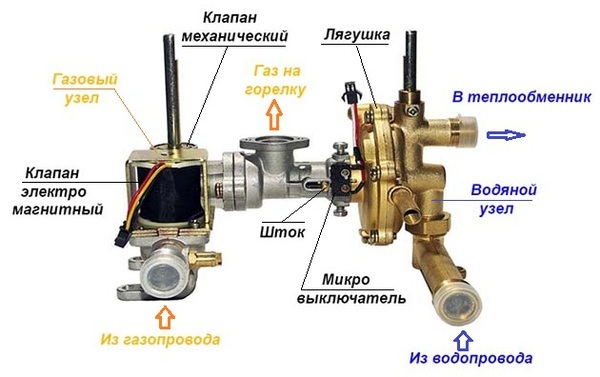
Structural elements and the principle of operation of the water unit. In common parlance, it is called a "frog". In the figure, yellow arrows show the direction of gas movement, blue arrows - the direction of water movement
Gas ignition method
In general, gas water heaters are based on three methods of gas ignition. As can be seen in the diagram, in all three cases the reaction of the water unit (frog) serves as a signal to ignite the main burner.
There are three ignition methods:
- using a piezoelectric element;
- from batteries;
- from the rotation of the hydraulic turbine.
Ignition with piezoelectric element - this is a manual ignition, and assumes the presence of a button on the front panel. Pressing the button causes the piezoelectric element to close, which ignites the igniter. He, in turn, ignites the main burner after a signal from the rod, which is moved by the water membrane with an active water pressure.
The igniter continues to burn with a small flame until it is manually turned off. This leads to increased gas consumption and increased scale formation in the pipes. One of the gas instantaneous water heaters with manual ignition is BoschTherm 4000 O W 10-2 P.
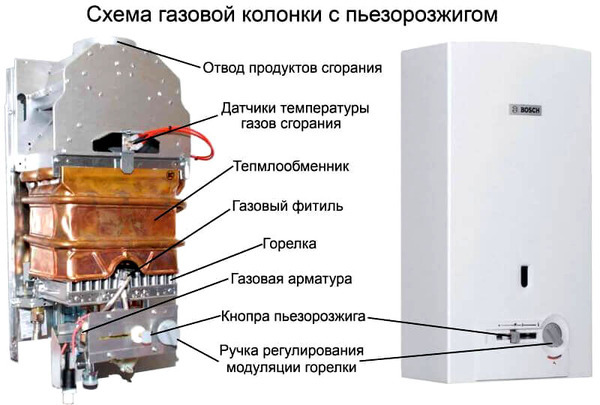
Diagram of a gas column with piezo ignition. The figure shows the "insides" of the column - the main structural units located inside the case, and buttons / knobs located outside
Geysers of some models work on batteries. Wherein igniting comes from an electrical spark after the rod signal. Thus, instead of an igniter, electrodes are present here, which directly ignite the main gas burner.
But batteries need to be changed on average once every 10 months, and with constant use — once every 2 months, so that there are no unforeseen circumstances. One of these battery-powered speakers is ZanussiGwh 10 FonteGlass La Spezia.
Sometimes ignition occurs from rotation hydro turbines (with water flow). Ignition also occurs from an electric spark, but the batteries do not need to be changed, because the turbine itself generates electricity during the flow of water.
But for the operation of the hydraulic turbine, a high pressure in the pipes is required, at least 0.3 bar. Not every house has this pressure. In Russia and other CIS countries, it is not advised to buy such columns due to the unstable water pressure. As an example of such a model - a gas water heater BoschTherm 6000 O WRD 15-2 G, which is noticeably more expensive than the above two models.
Column water assembly device
The device of the water unit is of particular interest. Its structure can be seen in the diagram below, detail captions are below the diagram. The rest of the designated elements are used for fasteners.
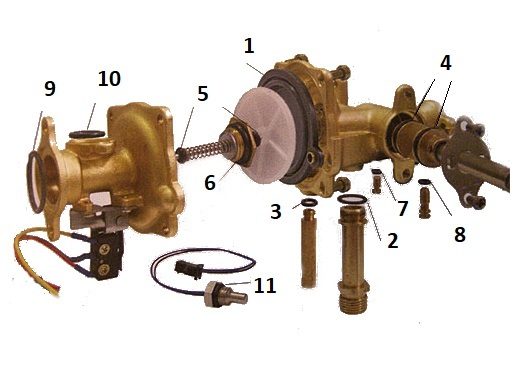
Constructive elements of a repair kit for a water unit of a gas column of the "Neva" brand: 1) silicone membrane D 54 mm; 2) an oil seal for the cold water inlet 19x14x2.5 mm; 3) drain valve oil seal 10x6x2 mm; 4) oil flow regulator oil seal 14.5x9.5x2.5 mm - 2 pcs; 5) the stuffing box of the stem seal thread M 12 x 1 5.34x1.78x1.78 mm - 2 pcs; 6) an oil seal of the rod sleeve M 12 x 1 14x11x1.5 mm; 7) an oil seal of the screw of the under-membrane pressure regulator 6.4x2.6x1.9 mm; 8) the gland of the screw of the water flow regulator 7хх3.2х1.9 mm; 9.) the gland for the connection of the water and gas units 27.5x23.5x2 mm; 10) a gland for connecting a water-gas unit with a burner 18x13x2.5 mm; 11) oil seal for water temperature sensor 10x6x2 mm
The main working details are stock and diaphragm, under the influence of which it moves when the flow of water begins in the lower part. The stem opens the valve and allows gas to flow into the burner, which is then ignited.
Another work item is pvc ball, which serves as a fuse. It shuts off the gas flow during sudden pressure drops in water pipes - hydraulic shocks, which we will also talk about later.
Combustion chamber type
According to the design of combustion chambers, there are two types of gas columns: open and closed.
Columns with open combustion chamber have open air access to the burner, and the combustion products go into the hood.
Such models are simpler than turbocharged, which will be discussed below, their operation is practically silent and in most cases they do not require electricity. However, due to the open connection between the combustion chamber and the room, air pollution in the room is possible if the hood works poorly.
Columns with closed combustion chamber are turbocharged. The combustion chamber in them is hermetically sealed, in addition to the channels for the injection and outlet of air. It is pumped there by a fan through coaxial pipes and goes outside through the chimney, together with the combustion products.
Such columns are usually fully automated, they do not have manual controls, and the thrust and temperature sensors in them are more sensitive. These speakers are “modern” and more secure.
The illustrations above showed a gas column with a closed combustion chamber. For comparison, in the following illustration, you can see the arrangement of two types of speakers side by side. You will find many similar elements with them, but the principle of removing combustion products is noticeably different.
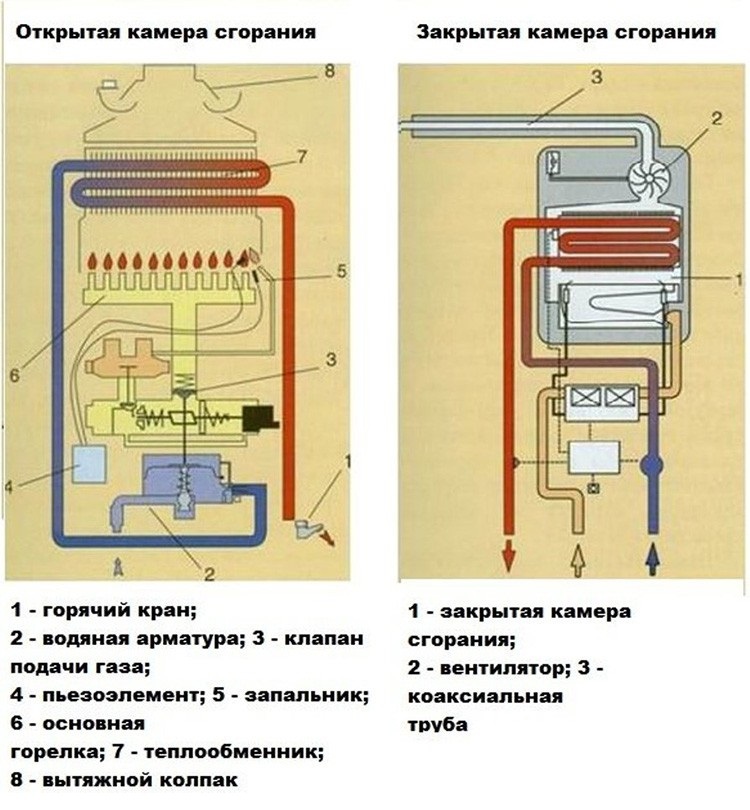
Comparison of combustion chambers in columns. On the left is an open column combustion chamber. On the right is a geyser with a closed-type combustion chamber, where air is forced into the chamber using a fan
Key features of the speakers
Now let's talk about the aspects of the practical use of the column. One of the main characteristics - performance. It directly correlates with the power, which is indicated in kW and shows the volume of water heated at 25 ° C per minute.
The characteristics are usually indicated in the passport of the device. An ordinary column heats 10-20 liters of water at 25 ° C per minute, although this value can fluctuate significantly.
Another characteristic of modern speakers —power modulation. It shows how the power of the column can change depending on the flow of water and is measured as a percentage of the initial power.
For modulation, the columns are equipped with special fittings with a membrane, which changes the gas supply to the burner depending on the flow. Modulation is considered normal in the range of 40-100% of the device's power.
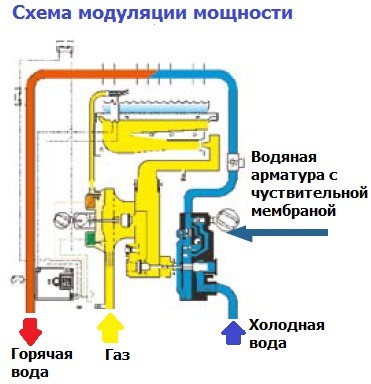
The diagram shows a modulating valve and its principle of operation, which is similar to the operation of a water unit and its membrane.
Safety sensors and their meaning
A gas water heater can be dangerous, because it is connected simultaneously with the water and gas mains, each of which, individually, can pose a threat.
In case of problems with the gas or water supply, safety sensors turn off the column, and special valves will shut off the water or gas supply.
Usually, gas water heaters can withstand a voltage of up to 10-12 bar, which is 20-50 times higher than the usual pressure in pipes. Such sudden jumps are possible with the so-called water hammer.
But if the pressure is lower than 0.1-0.2 bar, then the column will not be able to work. You need to carefully study the instructions and characteristics before buying in order to understand whether the column is optimized for low water pressure in the pipes of the CIS countries and whether it will work properly. And vice versa — whether it will withstand sudden pressure drops, which, alas, is also not uncommon in our conditions.
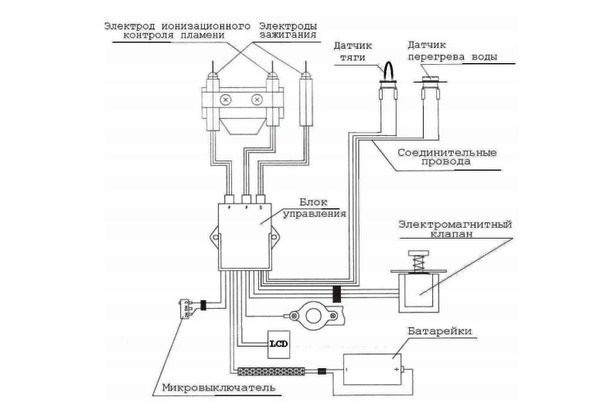
Ignition circuit of a burner powered by an electric spark. Locations of the main safety sensors of a household gas water heater
In general, a modern gas water heater contains many safety sensors. All of them, in case of breakdown, can be replaced.
More details about the purpose and location of the sensors are in the table below.
| Sensor name | Location and purpose of the sensor |
| Chimney draft sensor | Located at the top of the device, connecting the column to the chimney. Turns off the column in the absence of draft in the chimney |
| Gas valve | Located in the gas supply pipe. Turns off the column when the gas pressure drops |
| Ionization sensor | Located in the camera of the device. Turns off the device if the flame goes out when the gas is on. |
| Flame detector | Located in the camera of the device. Shuts off the gas if the flame does not appear after igniting |
| Relief valve | Located on the water inlet. Turns off water at elevated pressure in the pipeline |
| Flow sensor | Will turn off the column if water stops pouring from the tap or if the water supply is turned off |
| temperature sensor | Located on the heat exchanger tubes. Blocks the operation of the burner in case of significant overheating of the water in order to avoid damage and burns (it mainly works at + 85 ° C and above) |
| Low pressure sensor | Will not allow the column to turn on at a reduced water pressure in the pipes. |
Basic problems and how to fix them
Speaking about the structure and principles of operation of a household gas water heater, as well as the sensors built into it, it is worth briefly mentioning possible failures and malfunctions. Here we will not dwell on the complete repair or replacement of the column, but quickly go through all elements listed in the description of the burner, and describe their problems, as well as ways to cope with them with our own hands.
As already mentioned, the main element of the column —gas-burner. Often, the burner goes out due to the activation of the safety sensors, which we have already mentioned. Common problems that lead to this scenario — this is fouling of the heat exchanger soot and scale.
Cause weak pressure—scale formation in the pipes of the heat exchanger. In this case, you need to remove the heat exchanger and rinse the pipes with special descaling liquids.
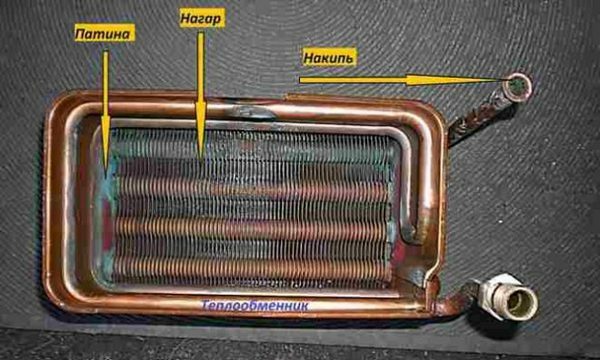
This photo shows a dirty heat exchanger. In this case, you need to remove it and clean out the soot. If the column is placed near the stove, the heat exchanger may also be contaminated with food fats.
If the combustion of gas does not occur completely, or the column is used for a long time, it accumulates in the chamber soot from the outside, which significantly reduces the thermal conductivity and quality of water heating.
To learn more about the causes of low pressure and the intricacies of cleaning, please go to this link.
If the gas valve does not open due to the low pressure of the supplied water, remove filter, check how much it is clogged and, if necessary, rinse. If there is an insufficient pressure of water or gas, you will have to contact the appropriate state service.
If water flows directly from the column, this means that the tightness is broken in the pipes. It is necessary to disassemble them and replace the sealing elements. If necessary, the pipes themselves will have to be replaced.
Separately, it is worth recalling faulty water membrane. If the column is in operation for a long time, the membrane of the water unit wears out and its sensitivity drops significantly. It stops responding to low water pressure, and, accordingly, does not give a signal that the burner needs to be ignited. In the best case, it should be changed every 5-6 years.
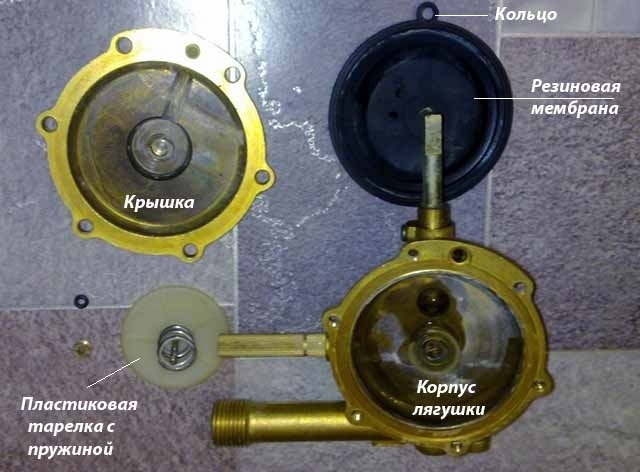
When the diaphragm is worn out, you can purchase a repair kit and replace it yourself. The water unit consists of such basic elements as a rubber membrane, a cover, a body and a plastic plate with a spring
Sometimes the problem is also in the stock, which moves by the membrane, it can also be replaced if necessary, because there are special repair kits for this.
In order to better understand the device of your geyser model, you need to carefully study the instructions for use and the passport of the object. This will not only save you time and hassle, but in itself will improve your understanding of how the device works.
Conclusions and useful video on the topic
To consolidate your understanding of the structure of the gas column, you can look video review, which explains in detail the location of all column elements using a live example:
In this article, we have studied the device of a household gas water heater, the principle of its operation. Then we examined the work of the main elements. And knowing the main components and elements of gas equipment, the sensors of its security system, you can diagnose a breakdown on your own. And if the cause of the malfunction is the contamination of individual structural elements, then perform self-service gas water heater.
Would you like to supplement the above material with useful recommendations or ask questions that we have not covered here? Ask our experts and other site visitors for advice - the feedback form is located below.
